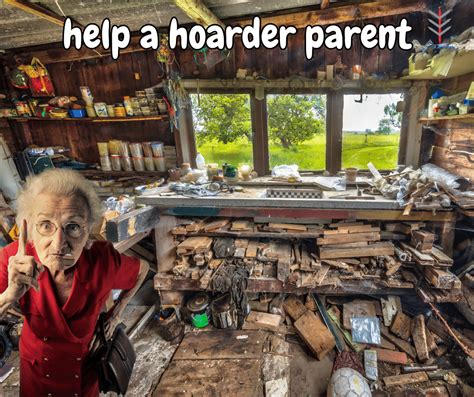Hoarding, a chronic mental health condition, affects an estimated 2.5 million people in the United States (National Institute of Mental Health, 2023). It’s characterized by an excessive accumulation of possessions, difficulty discarding items, and impaired daily living. Helping a hoarder parent can be an overwhelming task, but it’s crucial to approach the situation with compassion and understanding.

Understanding Hoarding
Understanding the underlying causes of hoarding can help you develop effective strategies for support. Common causes include:
- Trauma or loss
- Emotional attachment to possessions
- Fear of abandonment or inadequacy
- Cognitive impairments
- Genetics and brain chemistry
Addressing the Hoarding Issue
1. Approach with Empathy and Respect:
- Avoid judgment or criticism.
- Listen attentively to their reasons for hoarding.
- Validate their feelings, even if you don’t agree with them.
2. Set Realistic Goals:
- Don’t try to declutter everything at once.
- Start with small, manageable areas.
- Set achievable deadlines and break down tasks into smaller steps.
3. Seek Professional Help:
- Encourage your parent to seek professional therapy.
- Cognitive Behavioral Therapy (CBT) and Acceptance and Commitment Therapy (ACT) can be effective in addressing hoarding behaviors.
- Medications may also be prescribed to manage underlying anxiety or depression.
4. Gradual Decluttering:
- Work alongside your parent, assisting them in sorting through possessions.
- Focus on items that pose safety hazards or impede daily functioning.
- Use the “keep, toss, donate” method to categorize items.
5. Establish Boundaries:
- Clearly communicate that hoarding cannot impede your or their safety.
- Limit access to additional items that can be hoarded.
- Seek legal advice if necessary to establish boundaries regarding property and hoarding.
Supporting the Individual
1. Provide Emotional Support:
- Express your love and understanding.
- Listen without judgment or interruptions.
- Encourage them to share their fears and concerns.
2. Promote Self-Care:
- Help them establish a routine that includes sleep, exercise, and healthy eating.
- Encourage hobbies and activities that bring them joy.
- Foster social connections that provide support.
3. Address Underlying Issues:
- Explore the underlying causes of hoarding with them.
- Offer resources for trauma support, grief counseling, or financial assistance.
- Help them develop coping mechanisms for anxiety or depression.
4. Collaborate with Loved Ones:
- Gather support from family, friends, or neighbors.
- Share information about hoarding and the importance of understanding.
- Delegate tasks and coordinate efforts to provide ongoing assistance.
Tables for Reference
Table 1: Common Characteristics of Hoarding
| Characteristic | Description |
|---|---|
| Excessive accumulation | Possessing a large number of objects beyond reasonable need |
| Difficulty discarding | Inability to part with belongings, even those that have no value |
| Impaired daily living | Hoarding affects daily activities, such as sleeping, cooking, or using the bathroom |
| Distress or impairment | Hoarding causes significant distress or impairment in social, occupational, or other important areas of functioning |
Table 2: Risk Factors for Hoarding
| Risk Factor | Description |
|---|---|
| Trauma or loss | Experiencing traumatic events or losses can increase the risk of hoarding |
| Emotional attachment | Hoarders may develop an emotional attachment to objects, believing they hold sentimental or protective value |
| Fear of abandonment | Fear of being abandoned or not loved can lead to hoarding |
| Cognitive impairments | Difficulty with decision-making, attention, and memory can contribute to hoarding |
| Genetics and brain chemistry | Studies suggest a genetic component to hoarding, and brain chemistry imbalances may play a role |
Table 3: Symptoms of Hoarding Disorder
| Symptom | Description |
|---|---|
| Difficulty discarding | An inability to part with possessions, even those that have no value |
| Excessive accumulation | Possessing a large number of objects beyond reasonable need |
| Impaired daily living | Hoarding affects daily activities, such as sleeping, cooking, or using the bathroom |
| Distress or impairment | Hoarding causes significant distress or impairment in social, occupational, or other important areas of functioning |
Table 4: Treatment Options for Hoarding Disorder
| Treatment | Description |
|---|---|
| Cognitive Behavioral Therapy (CBT) | Helps hoarders identify and change their hoarding behaviors and thoughts |
| Acceptance and Commitment Therapy (ACT) | Focuses on helping hoarders accept their hoarding behaviors while developing strategies to live a more meaningful life |
| Medications | Antidepressants and anti-anxiety medications may be prescribed to manage underlying mental health conditions |
| Hoarding-specific therapy | Therapists trained in hoarding disorder can provide specialized treatment that addresses the unique challenges hoarders face |
